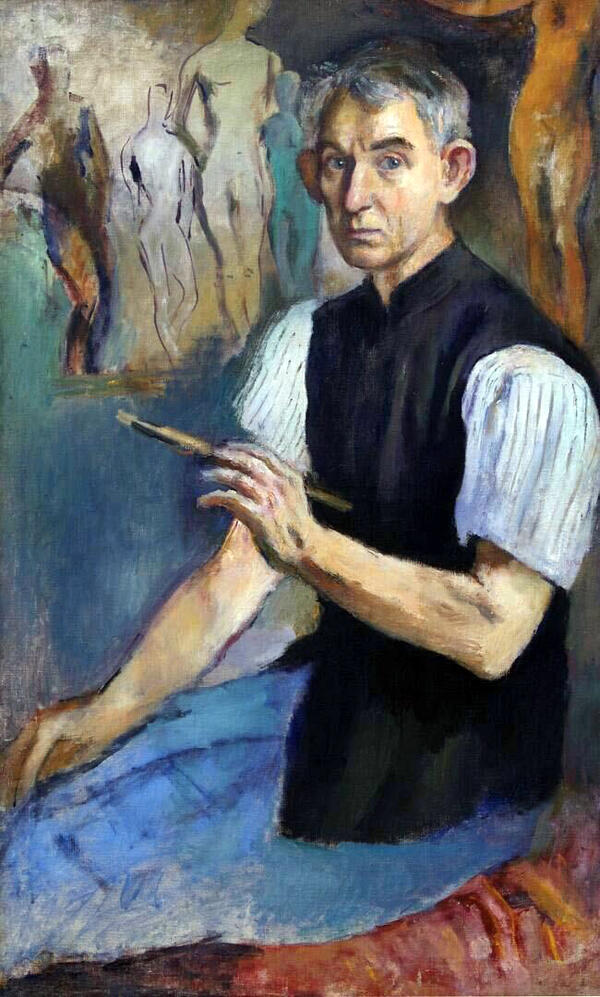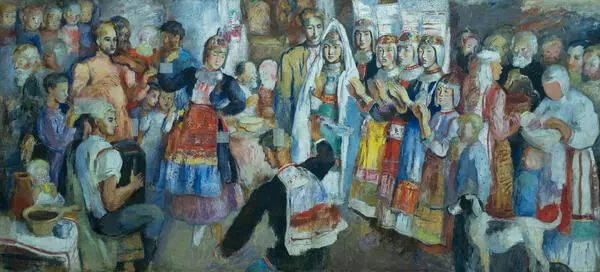Ivan Vasilyevich Dmitriyev was born on April 1, 1902, in the village of Novye Algashi, Simbirsk Governorate, in the family of an Orthodox priest. From 1920 to 1922, he studied at the Simbirsk Pedagogical Institute and the Izomuzoteo Art College. He graduated from the philological and linguistic department of the 2nd Moscow University in 1926, and from VKHUTEMAS-VKHUTEIN (the class of Dmitry Nikolayevich Kardovsky) in 1930. Not only was Dmitriyev a wonderful painter, but he also had a larger-than-life personality.
Despite the extremely harsh living conditions (for many years the artist had no home of his own, not even his own studio until 1980: due to political repressions against his father, he found himself isolated from the artistic life of the capital), Dmitriyev never ceased to paint, spoke several foreign languages and tirelessly learned new ones. In his memoirs, he described how at the beginning of the Second World War, under bombing, he went all the way across the blacked-out Moscow, where the prose of Dickens was narrated in English in a library. Music was his passion since childhood. A single, though significant fact: leaving to study in Moscow, still with no shelter in sight, Dmitriyev took his home piano with him. And this did not only become his livelihood (beginning from the post-war years, the artist earned his living by giving music lessons), but also the most important part of his paintings.
The silhouettes of the figures in the background refer to details of the artist’s biography. The search for the right image began with almost obsessive childhood memories, the figures of boys splashing in the river, which the artist recreated over and over again on the margins of notebooks and scraps of wrapping paper. Then the form was embodied in other media — papier-mâché and wood. Male and female figures coarsely carved from pieces of furniture picked up at a landfill, though having characteristic recognizable poses, were already completely abstract, and the rough sculptures fashioned from large wads of chewed newspaper looked more like creations of primitive artists. Later on, re-imagined and crystallized, those images became regular characters of numerous canvases, still lifes and portraits, true symbols of human beauty and harmony.
Despite the fact that Ivan Dmitriyev lived in Moscow since 1922, he never lost touch with his homeland. The artist said,
Despite the extremely harsh living conditions (for many years the artist had no home of his own, not even his own studio until 1980: due to political repressions against his father, he found himself isolated from the artistic life of the capital), Dmitriyev never ceased to paint, spoke several foreign languages and tirelessly learned new ones. In his memoirs, he described how at the beginning of the Second World War, under bombing, he went all the way across the blacked-out Moscow, where the prose of Dickens was narrated in English in a library. Music was his passion since childhood. A single, though significant fact: leaving to study in Moscow, still with no shelter in sight, Dmitriyev took his home piano with him. And this did not only become his livelihood (beginning from the post-war years, the artist earned his living by giving music lessons), but also the most important part of his paintings.
The silhouettes of the figures in the background refer to details of the artist’s biography. The search for the right image began with almost obsessive childhood memories, the figures of boys splashing in the river, which the artist recreated over and over again on the margins of notebooks and scraps of wrapping paper. Then the form was embodied in other media — papier-mâché and wood. Male and female figures coarsely carved from pieces of furniture picked up at a landfill, though having characteristic recognizable poses, were already completely abstract, and the rough sculptures fashioned from large wads of chewed newspaper looked more like creations of primitive artists. Later on, re-imagined and crystallized, those images became regular characters of numerous canvases, still lifes and portraits, true symbols of human beauty and harmony.
Despite the fact that Ivan Dmitriyev lived in Moscow since 1922, he never lost touch with his homeland. The artist said,




